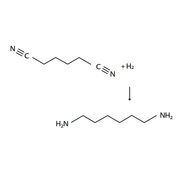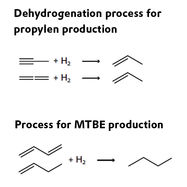
Building Blocks for Polymers
Polymers have become an indispensable part of our everyday lives. They are used in construction materials, coatings, adhesives, and countless other applications; including, automotive, electrical, and medical engineering. Polymers are cost-effective, robust, flexible and lightweight. Manufacturers require the appropriate quality and quantity of raw materials and high-performance catalysts to produce the necessary building blocks for polymers.
Markets change and new technologies emerge. This dynamic constantly challenges both polymer producers and suppliers of catalysts for industrial polymer production – by requiring both to be adaptive and flexible to satisfy market needs and demands. With decades of experience working in the industry and close contact with process technology providers, we’ve become a reliable and expert partner when it comes to catalysts for hydrogenation and oxidation reactions in the production of building blocks for polymers.
By choosing our active and highly selective catalysts, you can optimize selective hydrogenations and oxidations in the production of your polymer precursor, such as alpha-methyl styrene (AMS), olefins, resins, vinyl acetate monomer (VAM), or vinyl chloride monomer (VCM). At the same time, you’ll reduce the amount of unwanted byproducts.
Get in touch with us! Our applied technology service team will advise you on all questions regarding selective reactions with the help of fixed-bed catalysts for large-scale industrial applications. We are also your expert contact for individual catalyst solutions for the production of polymer building blocks.

Hexamethylenediamine (HMDA) is almost exclusively used to produce polymers: The vast majority of the diamine is consumed by the production of Nylon (PA 6,6) fibers and thermoplastic resins. While nylon fibers are commonly used to produce textiles and carpets, engineering thermoplastics have found a broad range of uses in the automotive industry.
HMDA is produced by the catalytic hydrogenation of adiponitrile (ADN), which is an alpha-omega dinitrile. There are several possibilities for side products due to the structure of ADN – and this needs to be considered in the design of the catalyst.
The activated nickel powder catalyst Metalyst® MC 502 is a highly active and very selective catalyst, specifically tailored for the hydrogenation of ADN to HMDA. It has optimized suspension and sedimentation properties for the bubble column reactor systems commonly used for HMDA production and operated as a semi-batch or continuous process.
Your benefits at a glance:
- Reduce your raw material costs with our highly active catalyst tailored for HMDA production.
- Even more cost-saving aspects you can benefit from, e. g., the catalyst extended lifetime and good recyclability.
- With the optimized metal composition for the specific reaction conditions, we can help you minimize reactor fouling leading to less frequent maintenance shutdowns.
Whatever challenge you face throughout the synthesis of your product, or if you don’t find what you are looking for in our comprehensive portfolio, our experts from custom catalysts are there to help you.

Olefins are a family of unsaturated, chemically active hydrocarbons having at least one double bond. C3/C4 olefins such as propylene (C3), butene (C4), or isobutylene (C4) are the major building blocks for polymers, e. g. polypropylene (found in car bumpers, fibers, containers and packaging). With decades of experience, we offer specific catalysts for the highly selective production of olefins.
Processing of C3 and C4 hydrocarbon streams requires a selective hydrogenation process (SHP) and/or a complete saturation process (CSP) unit to remove olefinic impurities. Our Noblyst® H14171 and Noblyst® H14271 are highly active palladium/alumina catalysts for these liquid phase process types. The palladium is dispersed with special technology to get a very thin (<50 µm) palladium shell in the outer zone of the alumina.
These catalysts permit operation at low temperatures and high space velocities, e. g. in the following processes:
- Dehydrogenation of propane to propylene: After the dehydrogenation unit, the separated propylene stream contains methyl acetylene and propadiene, which both are then hydrogenated in the SHP unit to gain the main product: propylene.
- MTBE (methyl tertiary butyl ether) Production: After the separation of MTBE, the remaining linear olefins and diolefins are finally saturated to butanes in a CSP unit which can be fed back into the isomerization process.
Your benefits at a glance:
- The Noblyst® family has been optimized over three decades to suit your needs in a broad range of applications.
- Our catalysts offer you higher quality and efficiency in your production process.
Petroleum resins are thermoplastic, hydrocarbon polymers derived from monomers of cracked petroleum fractions such as C5, C9 and DCPD (dicyclopentadiene) feedstocks. Due to their tackifying effects, they are suitable for producing paints and varnishes, coatings, printing ink, adhesives, rubber, and many more.
Petroleum resins can be hydrogenated to improve properties like color and light stability. Water-white resins suitable for demanding applications such as adhesives for transparent pressure-sensitive tape can be obtained. Hydrogenation can improve the adhesive properties and the compatibility of petroleum resins with ethylene-vinyl acetate copolymers used in hot-melt adhesives.
Most of the standard hydrogenation catalysts are effective for the hydrogenation of petroleum; however, nickel catalysts are the most common ones used today. We offer nickel powder catalysts for slurry processes (Metalyst® MC 1**) and supported nickel catalysts for fixed bed processes (Octolyst® 10126).
- Metalyst® products are activated metal catalysts based on nickel, cobalt, or copper, delivered either in water or embedded in a fat matrix for water-free processes.
- Octolyst® base metal catalysts contain active components from Group VIII metals and optionally copper or other elements. Evonik offers these catalysts with high and low loading, including grades that are suitable even for sulfur-containing feeds.
Your benefit at a glance:
- Within our family of high-quality and efficient nickel powder catalysts for the hydrogenation of petroleum, you can choose between catalysts for slurry processes (Metalyst® MC 1**) and fixed bed processes (Octolyst® 10126).

The copolymer alpha-methylstyrene (AMS) is used in various applications, such as coatings, rubbers, or adhesives. The colorless and liquid AMS is not produced standalone. It is one of the byproducts in the phenol process (Hock process), used for industrial production of phenol and acetone starting from cumene.
AMS can be separated and used as a copolymer. However, in most cases phenol plant operators aim to improve process efficiency rather than opting for the AMS as product, and therefore selectively hydrogenate the AMS back to cumene and feed it back to the oxidation step.
The Noblyst® H14108 and the next generation Noblyst® 1515 are palladium on alumina catalysts, specifically developed and tailored for the AMS hydrogenation. By using these catalysts, the hydrogenation process can run under mild reaction conditions. Both catalysts are robust, specifically developed for the Evonik MSHP process, with lifecycles of more than 5 years – plus they can reach reduction levels of AMS up to below 100 ppm. Our Noblyst® 1515 contains 40 % less palladium, ensuring high performance and long lifetime operations while the palladium can still be recovered at the end of the catalyst’s lifecycle.
Your benefits at a glance:
- We are your reliable and successful partner that stands by you with more than 10 phenol lines serviced globally and a track record of more than 20 years.
- Take advantage of our broad set of documentation.
- Our technical experts will be available during initial reactor load, start-up and recharges.
If you cannot find what you are looking for in our comprehensive portfolio, our experts from custom catalysts are happy to leverage all our competencies to provide you with sophisticated catalysts tailored exactly to your needs.

Vinyl Acetate Monomere (VAM) is the monomer to build polyvinylacetate (PVAC), which for example, is used in adhesives, paper and textile impregnation, and as component of chewing gums. The industrial production of VAM using the Bayer Process involves the gas-phase reaction of ethylene with acetic acid and oxygen (see picture).
With a track record of more than 25 years at leading VAM producers, we offer proprietary catalysts with high activity and selectivity at low precious metal usage. Using the Bayer Process, the selective oxidation of ethylene can be performed using our Noblyst® 8000 series, which operates convincingly with special bimetallic palladium and gold catalysts supported on silica
Your benefits at a glance:
- Our Noblyst® 8000 series shows high performance with less precious metal content than standard commercially available VAM catalysts, thus providing you a remarkable cost advantage.
- You can rely on our sound understanding of the process, enabling and supporting your optimized operation.
- With your specific requirements in mind, Evonik can customize our portfolio of VAM catalysts to meet your project needs.
Are you facing unprecedented challenges? Cannot find what you are looking for in our comprehensive portfolio? Then speak with one of our experts from custom catalysts to help you get started.

Vinyl chloride monomer (VCM) is one of the twenty largest petrochemicals. It is the building block for polyvinyl chloride (PVC), a polymer used e.g. in the construction industry (flooring, insulation, profiles).
The raw material ethylene is converted to ethylene dichloride (EDC) which is then purified to remove side products. Subsequently, VCM and HCl are obtained by pyrolysis. Traces of acetylene are formed as side product that remain in the HCl recycle stream.
Our Noblyst® E39H and Noblyst® E39K are two catalysts that offer high activity, ethylene selectivity and EDC purity. They show extended lifecycles while minimizing by-product formation of undesirable chlorinated hydrocarbons, and they allow a high recovery rate of the precious metal from the spent catalyst. Fouling rates in the EDC cracking furnace are reduced.
- Noblyst® E39H shows the highest robustness in case of expected frequent shutdowns, e.g., for catalyst sieving. In a selective hydrogenation process, the unwanted acetylene is selectively hydrogenated to ethylene, which can then be recycled into the oxychlorination process.
- Noblyst® E39K is recommended for higher space velocities. The Pd/Si catalyst is designed for a high gas load mode of selective hydrogenation of acetylene to ethylene in the HCl recycle stream.
Your benefits at a glance:
- By using our long-life and high quality catalysts, you’ll be able to saveresources in VCM production.
- Experience stable operations and cost-savings from the minimized separation and disposal of undesired chlorinated hydrocarbon by-products.
- Take advantage of our high quality catalysts that have been proven in 50 VCM production lines all over the world.
WE ARE HAPPY TO ADVICE YOU
You did not find the right product?
We can help.
